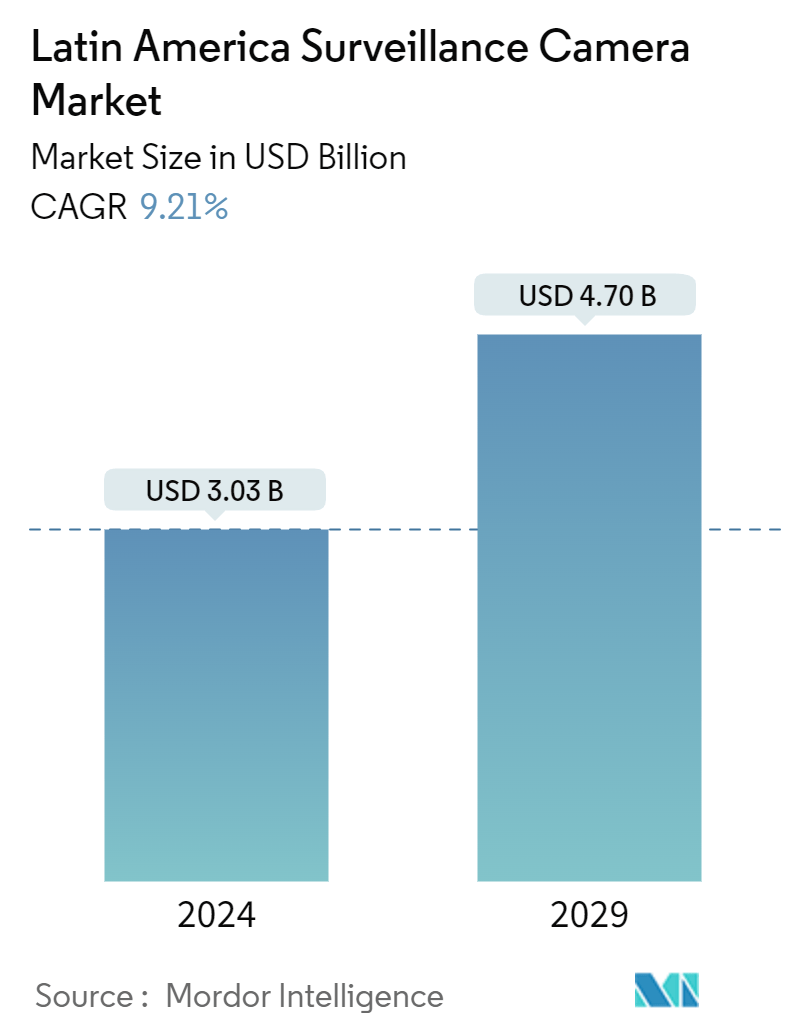Market Size of Latin America Surveillance Camera Industry

| Study Period | 2019 - 2029 |
| Base Year For Estimation | 2023 |
| Market Size (2024) | USD 3.03 Billion |
| Market Size (2029) | USD 4.70 Billion |
| CAGR (2024 - 2029) | 9.21 % |
| Market Concentration | Low |
Major Players
*Disclaimer: Major Players sorted in no particular order |
Latin America Surveillance Camera Market Analysis
The Latin America Surveillance Camera Market size is estimated at USD 3.03 billion in 2024, and is expected to reach USD 4.70 billion by 2029, growing at a CAGR of 9.21% during the forecast period (2024-2029).
Surveillance cameras have experienced a rapid expansion, incorporating and adapting to new trends and technologies, such as machine learning, night vision, infrared, thermal imaging, video analytics, AI (artificial intelligence), and IoT (Internet of Things), to provide end users with comprehensive security solutions. Not only are surveillance cameras cost-effective, but they are also simple to set up and maintain. Furthermore, they have a high degree of scalability, allowing them to be upgraded or downgraded at any time.
In Latin America, the demand for surveillance cameras is rising due to several factors, including growing urbanization, increasing awareness of the necessity of security measures, and increasing criminal activity. For instance, according to InSight, a crime organization, in 2023, Jamaica was the leading country in terms of the number of homicides recorded in Latin America and the Caribbean, followed by Ecuador, Haiti, Trinidad and Tobago, Honduras, and Venezuela, among others.
Furthermore, the recent innovations in the technological capabilities of surveillance cameras also encourage people to adopt them to enhance the safety quotient of their premises. For instance, facial recognition technology has further advanced the capabilities of surveillance cameras, enabling them to identify and monitor individuals more effectively.
Surveillance technology is on the rise in Latin America, particularly in Mexico. Over the last decade, Mexico has implemented the largest video surveillance system in the Americas, significantly impacting criminal investigations. One presidential candidate aims to enhance the system by incorporating additional biometrics. For the past two decades, the city's administrations have prioritized video surveillance as a key tool in combating the surge in violent crime, largely attributed to the drug war. The last five years have witnessed a sharp uptick in the deployment of surveillance cameras. Presently, Mexico boasts a network of over 64,000 cameras, with plans to surpass 80,000 by the close of 2024.
In Argentina, the installation of surveillance cameras has grown significantly in recent years. The Comprehensive Video Surveillance Plan (CVSP) of the Argentine government (Ministry of Justice and Security) of Buenos Aires (the City of Buenos Aires) commits to monitoring 75% of city video surveillance. Implementing the CVSP was possible due to the incorporation of surveillance cameras, as the government believes surveillance cameras are essential for preventing criminal activity and promptly resolving illegal activity.
The emergence of the IoT has enabled surveillance cameras to be integrated with other smart devices, creating a comprehensive and interconnected security infrastructure. This integration allows users to monitor the cameras remotely, receive real-time alerts, and integrate with other smart home and business automation systems to provide comprehensive security data automatically to local law enforcement and safety alerts to residents via mobile phones.
In recent years, there has been an increased awareness of the potential for privacy and the ethical implications of extensive surveillance. While these technologies have been demonstrated to be beneficial in improving public security, there are still concerns about the privacy and ethical implications. For instance, in July of 2023, Sao Paulo announced the implementation of thousands of facial recognition surveillance cameras in the Brazilian metropolis. However, authorities are concerned that this technology's indiscriminate application could exacerbate structural racism and inequalities, as well as potential risks to data security and cybersecurity.
Furthermore, the higher cost of advanced surveillance cameras, the lack of skilled workers to operate IP cameras, and lower awareness across several countries continue to challenge the surveillance camera market's growth in Latin America.
Latin America Surveillance Camera Industry Segmentation
Surveillance cameras are gaining popularity for their cost-effectiveness and user-friendly nature. This surge has seen a rise in installations across residential and commercial spaces, all aimed at enhancing security. Thanks to technological advancements, these cameras are reshaping the security landscape. They come in a variety of styles and resolutions, tailored for different needs, including indoor, outdoor, box, dome, bullet, IP, day and night, wireless, thermal imaging, PTZ, and beyond. The market is defined by the revenue accrued from the sales of different types of surveillance cameras over various end users across Latin America.
The Latin American surveillance camera market is segmented by type (analog-based, IP-based, and hybrid), end-user industry (government, banking, healthcare, transportation and logistics, industrial, and other end-user industries [educational institutions, retail, and enterprise]), and country (Brazil, Mexico, and Rest of Latin America). The market sizes and forecasts are provided in terms of value (USD) for all the above segments.
| By Type | |
| Analog-based | |
| IP-based | |
| Hybrid |
| By End-user Industry | |
| Government | |
| Banking | |
| Healthcare | |
| Transportation and Logistics | |
| Industrial | |
| Other End-user Industries (Education Institutions, Retail, and Enterprises) |
| By Country*** | |
| Brazil | |
| Mexico |
Latin America Surveillance Camera Market Size Summary
The Latin America surveillance camera market is experiencing significant growth, driven by the increasing need for security solutions amid rising urbanization and criminal activity. The market is evolving with the integration of advanced technologies such as artificial intelligence, machine learning, and IoT, which enhance the capabilities of surveillance systems. These innovations have made surveillance cameras more appealing due to their cost-effectiveness, ease of installation, and scalability. Countries like Mexico and Argentina are leading the charge in adopting these technologies, with extensive surveillance networks being established to combat crime and enhance public safety. The demand for IP-based camera systems is also on the rise, fueled by the need for improved residential security and the adoption of cloud-based solutions that offer remote management and real-time alerts.
Despite the promising growth trajectory, the market faces challenges such as privacy concerns, high costs of advanced systems, and a shortage of skilled personnel to operate these technologies. However, the market is becoming increasingly competitive, with numerous players entering the space and adopting strategies like partnerships, product launches, and mergers to maintain their market positions. Key players such as i-PRO, Verkada Inc., and Genetec Inc. are actively expanding their offerings and market presence. The ongoing urbanization in countries like Brazil further propels the demand for surveillance cameras, as they are essential for monitoring public spaces and securing infrastructure. As the market continues to evolve, the focus on integrating surveillance systems with smart devices and cloud technologies is expected to drive further growth and innovation in the region.
Latin America Surveillance Camera Market Size - Table of Contents
-
1. MARKET INSIGHTS
-
1.1 Market Overview
-
1.2 Industry Attractiveness - Porter's Five Forces Analysis
-
1.2.1 Bargaining Power of Suppliers
-
1.2.2 Bargaining Power of Consumers
-
1.2.3 Threat of New Entrants
-
1.2.4 Threat of Substitutes
-
1.2.5 Intensity of Competitive Rivalry
-
-
1.3 Impact of Macroeconomic Factors on the Market
-
-
2. MARKET SEGMENTATION
-
2.1 By Type
-
2.1.1 Analog-based
-
2.1.2 IP-based
-
2.1.3 Hybrid
-
-
2.2 By End-user Industry
-
2.2.1 Government
-
2.2.2 Banking
-
2.2.3 Healthcare
-
2.2.4 Transportation and Logistics
-
2.2.5 Industrial
-
2.2.6 Other End-user Industries (Education Institutions, Retail, and Enterprises)
-
-
2.3 By Country***
-
2.3.1 Brazil
-
2.3.2 Mexico
-
-
Latin America Surveillance Camera Market Size FAQs
How big is the Latin America Surveillance Camera Market?
The Latin America Surveillance Camera Market size is expected to reach USD 3.03 billion in 2024 and grow at a CAGR of 9.21% to reach USD 4.70 billion by 2029.
What is the current Latin America Surveillance Camera Market size?
In 2024, the Latin America Surveillance Camera Market size is expected to reach USD 3.03 billion.

